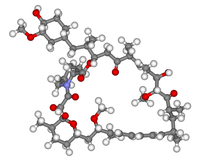
Photo from wikipedia
Background/rationale: Diffuse intrinsic pontine glioma (DIPG) in children remains essentially incurable with a median survival of 12 months. Radiation therapy is currently the standard treatment modality. To date chemotherapy or… Click to show full abstract
Background/rationale: Diffuse intrinsic pontine glioma (DIPG) in children remains essentially incurable with a median survival of 12 months. Radiation therapy is currently the standard treatment modality. To date chemotherapy or biologic agents have had no meaningful increase in survival, making it imperative to profile novel therapeutic combinations. Data from biopsied DIPG showed the PI3K/AKT/mTOR pathway as a major oncogenic player. At the gene level high PDGFR amplification and overexpression of the PI3K-Akt-mTOR pathway were noted in these tumors. Focal amplifications of genes within the PI3K-Akt-mTOR signaling pathway were found in 47% of DIPG. Thus targeting these pathways with mTOR inhibitors could hold promise. Elevated expression of DNA repair proteins in the NHEJ and HRR pathway are known to induce resistance to radiation. Preclinical data shows inhibition of these pathways potentiates the sensitivity of these tumors to radiation. Recent genomic and epigenetic insights demonstrates the role of histone deacetylase (HDAC) in these tumors. Vorinostat a pan HDAC inhibitor has been associated with decreased expression of key DNA repair proteins in both the NHEJ and HRR pathways and have been tested in clinical trial for children with DIPG. Both temsirolimus (an mTOR inhibitor) and vorinostat are well described in pediatric clinical trials with a determined maximum tolerated dose (MTD). The efficacy of the combination of temsirolimus and vorinostat has been well-established in other malignancies including prostate cancer, mantle lymphoma, and renal carcinoma. This is the first multi-targeted therapeutic trial in pediatric DIPG, using vorinostat and temsirolimus in a combinatorial approach, targeting the key oncogenic pathway and molecules along with enhancing the radiation sensitivity. Correlative study: Stratum I (chemoradiotherapy phase): Histone acetylation will be quantified from peripheral blood mononuclear cell (PBMC) collected prior to the first dose of vorinostat and radiation and at the end of radiation. Stratum I and II (maintenance phase): Evaluation of histone acetylation, phosphorylated 70S6K and Akt on day 1 and 8 (prior to chemotherapy with temsirolimus) during cycle 1 and cycle 2 will be performed. Methods: Patients with a performance score of 50 or greater with newly diagnosed (Stratum 1) or progressive DIPG (stratum II) as confirmed by gadolinium enhanced MRI, will be eligible. Biopsy is not mandatory. Stratum I: Patients will receive radiation therapy concurrently with vorinostat on the days of radiation at a dose of 230 mg/m2/dose orally, followed by maintenance phase with vorinostat and temsirolimus for 12 cycles if patients do not have progressive disease. Stratum I and Stratum II (maintenance phase): Patients will receive vorinostat and temsirolimus for 12 cycles (28 day cycle), if patient do not have progressive disease. Vorinostat will be given once daily orally at 230 mg/m2/dose orally from day 1 to day 8, along with temsirolimus at 25mg/m2 intravenously on day 1 and day 8. This will be dose level 1 with provisions for 2 higher dose levels and 1 lower dose level if needed. A standard 3+3 design will be used and a minimum of 9 patients and a maximum of 18 patients will be enrolled. Trial is continuing as planned and patient are on dose level 1. Trial: NCT02420613 (currently recruiting). Citation Format: Soumen Khatua, Vidya Gopalakrishnan, Joya Chandra, Leena Ketonen, David I. Sandberg, Jeffrey Weinberg, Fuller Gregory, Kenneth R. Hess, Natalie Slone, Heather Meador, Mirriam Morrell, Wafik Zaky. A phase I study of vorinostat and temsirolimus in children with newly diagnosed or progressive diffuse intrinsic pontine glioma (DIPG) [abstract]. In: Proceedings of the American Association for Cancer Research Annual Meeting 2017; 2017 Apr 1-5; Washington, DC. Philadelphia (PA): AACR; Cancer Res 2017;77(13 Suppl):Abstract nr CT029. doi:10.1158/1538-7445.AM2017-CT029
Journal Title: Cancer Research
Year Published: 2017
Link to full text (if available)
Share on Social Media: Sign Up to like & get
recommendations!